College Football is Facing an Existential Crisis. Here’s an Out-of-the-Box Idea to Save it.
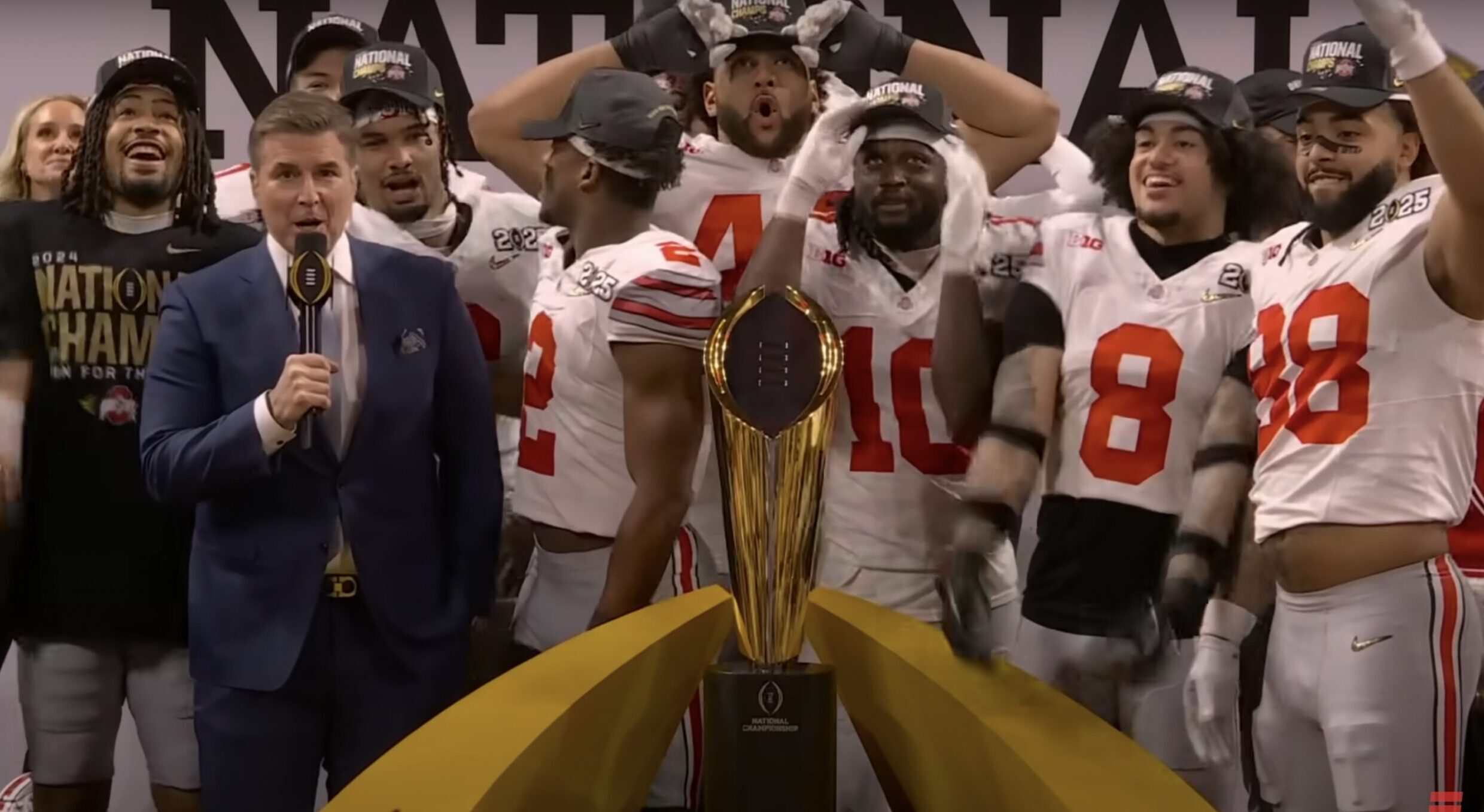
Screenshot
The next American sports league to make an obscene amount of money will be the one which figures out how to successfully incorporate a promotion and relegation model. This model dictates that the best teams in a given league can rise to higher levels, while the worst fall down to lesser leagues.
Imagine the likes of Alabama football being forced to play a season-ending game in which it faces expulsion from the SEC if it loses — with no guarantee it would ever get back. Such a game would provide the highest level of drama. This thrilling structure has been a staple of European soccer for decades, and its arrival on this side of the Atlantic is long overdue.
The challenge is that incorporating such a model will require vision and a willingness to sacrifice from top executives. Unfortunately, most of the power brokers in American sports seem to be lacking in both.
So today, I’m going to help take care of the vision part with a detailed plan for how promotion and relegation can truly work in college football. It’s complicated, and certain to have a few bugs. But at its core, the sport has to adopt a model similar to this one — or face a worsening inequity that will ultimately result in its demise.
And as for the sacrifice part? In this plan, the only real sacrifice here will be required from schools and leagues which are about to get screwed anyway. And even those sacrifices will be short-term and minimal. Frankly, the impacted entities will all fare much better in the long run if a plan like this were to be adopted than they would if the status quo were to prevail.
And that’s the key point here. The status quo is going to ruin college football. It’s not a matter of if, but when. It’s becoming very expensive to maintain a top program. (And the recent House settlement, which clears the way for schools to directly pay players, will make it even more costly.) The gap between the haves and the have-nots — which has always been pretty big — is about to become enormous. Something has to change, and soon.
***
The future of college football is a dominant topic of conversation right now, as the conferences are holding their annual media days, and league commissioners are laying out their visions for how the sport will look going forward. The two top conferences — the SEC and the Big 10 — are positioning themselves to gobble up the majority of the spots in the College Football Playoff. The SEC is pushing a plan where 11 of 16 teams in an expanded playoff would be chosen on an at-large basis. That proposal would dramatically benefit that league, as well as the Big 10. (Although the Big 10 seems to prefer a model that guarantees four playoff berths for their conference, as well as the SEC.)
The writing is very much on the wall. The SEC and the Big 10 clearly want to break away from the rest of college football to form a Super League. The other two “power” conferences — the ACC and the Big 12 — can’t really do much to stop it. Save for a couple of schools like Clemson and Miami, the quality of the programs in the ACC and Big 12 just doesn’t measure up to the SEC and Big 10. They don’t have great leverage at the bargaining table.
SEC Commissioner Greg Sankey, undoubtedly the most powerful executive in college football, delivered a very clear message on Monday — when he spoke at the conference’s media confab.
“For those of you who like to speculate about super conferences — welcome to one,” Sankey said.
Not much need to read between the lines there. The Super League is going to happen sooner or later. The money is too big for it not to.
But the Super League doesn’t necessarily need to be a death warrant for the teams who aren’t in it. There is a way the ACC and the Big 12 can not only retain their relevance, but actually enhance it. Same for the so-called “Group of Five” conferences. (Soon to be Group of Six — when a reconfigured PAC 12 launches in 2026.) It’s with a promotion/relegation model — a model which, frankly, is tailor-made for college football.
The idea is not entirely new. There are countless Reddit threads devoted to the topic. Most prominently among national voices, ESPN’s Bill Connelly has written extensively about this subject and come up with several promotion/relegation models. But what this model factors in that Connelly’s and others haven’t is an SEC/Big 10 power grab which is unquestionably going to happen — whether the other leagues like it or not. This model grants those leagues the massive power they’re seeking, but also secures the futures of the lesser conferences.
I weighed publishing this on a Substack or some other outside blog because, on the surface, this kind of post would seem to be a bit outside our lane at Mediaite. But in the end, I decided to run it here because the restructuring of college football is an enormous sports media story. Rights holders like Fox, CBS, NBC and especially ESPN have powerful voices in this debate. They want more quality inventory, and this proposal would increase it exponentially. A late-season tilt between 3-8 Kentucky and 2-9 Vanderbilt would suddenly become a hot property if both teams were fighting for their SEC lives. This plan is a TV rights holder’s dream. You can bet something like this will have its share of advocates at the networks.
In one of his many articles floating a model for promotion and relegation in college football, ESPN’s Connelly wrote, “If you’ve wasted countless hours of your life thinking about something, the least you can do is share some of those thoughts when they become even slightly relevant.” In my case, I wouldn’t say it was countless hours, but rather a long weekend home alone while my wife was traveling. (Sorry I couldn’t mow the lawn, honey. I was “working.”)
But there’s no question that right now, this kind of plan is very relevant — because the changes being discussed now will shape the future of the sport for decades. If certain schools and conferences can swallow a little pride in the short-term, a windfall for everyone awaits. Let’s hope the better angels prevail.
***
THE BASICS
So here’s the gist…This proposal calls for five tiers — each featuring two conferences:
Tier 1 — The Super League (Big 10 and SEC)
Tier 2 — The Elite League (Big 12 and ACC)
Tier 3 — The Contender League (PAC 12 and AAC)
Tier 4 — The Up-and-Comer League (MAC and Sun Belt)
Tier 5 — The Starter League (MWC and Conference USA)
The top teams in each tier at the season get promoted to the next-highest tier (except, obviously, for Tier 1) — while the teams at the bottom get relegated to the next lowest tier. The premise being that the likes of Rutgers, Maryland, and other bottom feeders will soon be weeded out, while the best programs in the lower levels work their way up.
Here’s how the five tiers break down:
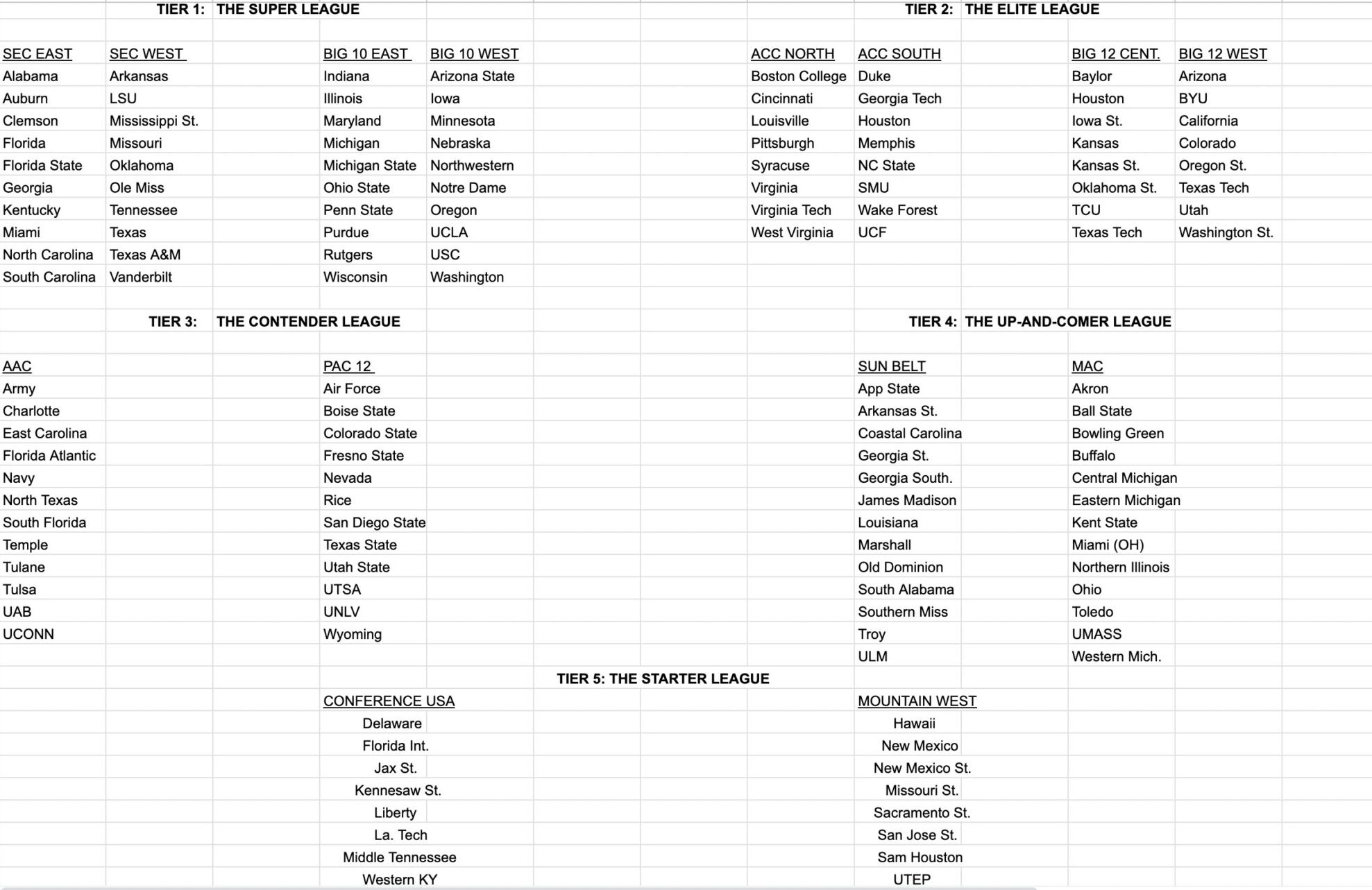
Screenshot
The 40 Super League teams — and only the 40 Super League teams — will compete for the national championship. In the lower tiers, you can win a title on your level, but that’s it. Let’s face it, there are — at most — that many teams who can legitimately compete to win the national title right now. (No team outside the 40 we’re including in the Super League has won the national championship since 1990. This structure merely codifies what is already a harsh reality.)
In this model, teams are matched up with opponents their own size. Division championships are attainable for everyone. No more computer rankings. No more selection committees. No more watching your 12-0 team get snubbed in favor of the 10-2 powerhouse. Titles are decided on the field. Everyone has a fair shot.
And if you truly belong among the big boys, you’ll get there eventually. The cream will rise to the top. A true college football meritocracy.
Of course, the devil lies in the details here. And so, below, you’ll find the specifics on how a system like this would work.
***
THE FINE PRINT
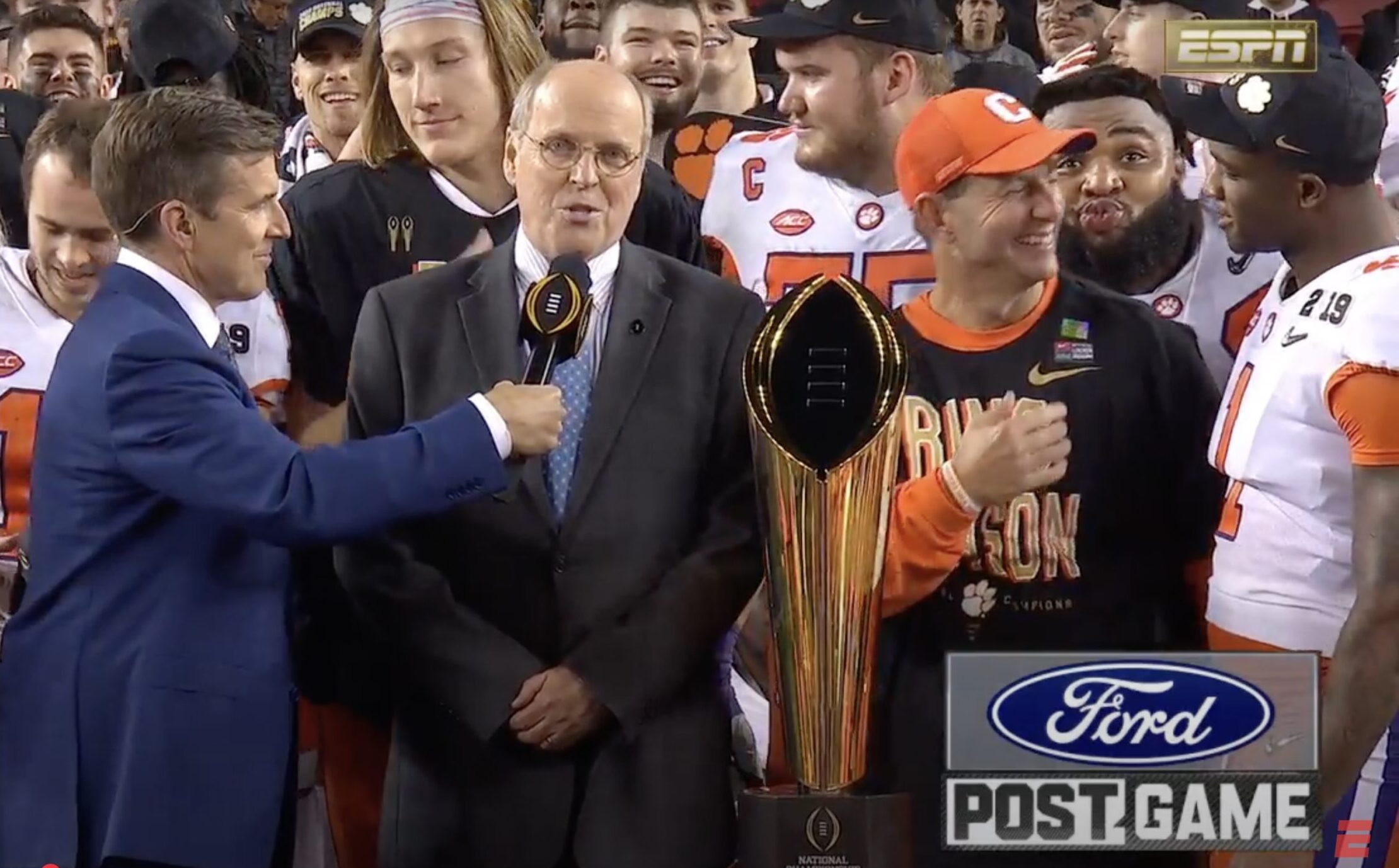
Screenshot
Tier 1 — The Super League (SEC and Big 12)
Clemson, Florida State, Miami, and Notre Dame will all (rightfully) scream bloody murder if they are not part of this Super League league from the jump. All four belong. So in order to minimize opposition to this plan, you’ll have to add them. Clemson, Florida State and Miami would join the SEC, while Notre Dame would join the Big 10. That brings each conference to 19 members.
From there, you’re obviously going to add one more to get to 20. But it speaks to the dramatic imbalance between this top tier of teams and the teams in the ACC and the Big 12 that finding another team from those conferences worthy of Super League inclusion is not easy. For now, let’s add North Carolina (thank you Bill Belichick … and Jordon Hudson) and last year’s Big 12 champ Arizona State.
Each conference will be split into two 10-team divisions. All teams in each division will play each other. The final three games will be out of division and be weighted based on the previous year’s standings so that all teams face as close to an equal strength of schedule as possible. (Example: Team A from the SEC East could play the No. 1 team from the Big 10 East, the No. 10 team from the Big 10 West, and the No. 5 team from the SEC West … while Team B from the SEC East Team B could play team No. 3 from the Big 10 East, team No. 4 from the Big 10 West, and team No. 9 from the SEC West. And on and on until all the schedules are weighted equally.)
No more of the ridiculous mismatches that currently dominate out-of-conference play — as programs look to fatten up their records. It is the height of absurdity that Texas — possibly the No. 1 team in the country heading into the 2025 season — will play a quarter of its games against San Jose State, Sam Houston, and UTEP. What a waste of time. If any of those teams stay within 35 points of the Longhorns, it will be a minor miracle. This proposal eliminates those body bag games. All the powerhouses will be forced to pick on teams their own size.
Now, with a 16 team college football playoff already on the table, there’s no chance these conferences are turning their back on any of that TV revenue. So you’re getting a 16-team playoff here in this system, even though eight would probably suffice. The top four in each division will qualify for the playoffs. The SEC teams and Big 10 teams only play each other (a la the AFC and the NFC in the NFL) until the title game — when the winners of the two conferences will meet to determine a national champion.
And here’s where it gets really fun: The bottom two teams in each division qualify for the relegation playoffs. The two last place teams in each SEC division play each other. Same in the Big 10. The losers of those games are relegated. Down to the second tier they go. The victors get a temporary reprieve, but must then win one additional game to avoid relegation.
Meanwhile, the second-to-last place teams in each division also square off against each other. The winners of those games secure their spot in the Super League for the next season. The losers? They get one more shot to survive — as they take on the winners of the games between the two last place teams. And then the losers of those games also get relegated.
So four teams total will go down to Tier 2 each season. (Last season, as an example, Kentucky, Mississippi State, Maryland and Purdue would have been relegated.) The relegated SEC teams go down to the ACC, while the relegated Big 10 teams land in the Big 12.
The networks will love this plan, as there will be no shortage of quality inventory. Think of it like this: 24 out of the 40 Super League teams will qualify for some sort of postseason football. Sixteen will be in the hunt for a natty, while eight will be fighting for Super League survival. And the other 16 figure to be in the mix for either the playoffs or relegation for most of the season. So almost everyone will be playing meaningful games in November. How great is that? Compare it to the current system — where at least three-quarters of teams have their hopes dashed by the end of September.
The only pushback among Tier 1 squads is likely to come from the biggest relegation candidates: the Marylands, the Purdues, the Vanderbilts. But in this system, those schools become dramatically more relevant overnight. If they manage to stay in the top tier for a couple of seasons, they can build their programs to a level where they really matter.
And if they can’t, they go down to a level where they can legitimately compete. Do Maryland fans really get enjoyment out of watching Ohio State beat them 45-10? Maryland spent many years in the ACC. It won’t be the worst thing in the world for them if they have to go back.
And as for the big boys? The Alabamas, the Ohio States, the Georgias? They’ll never actually get relegated. The proof lies in British soccer’s Premier League — where only twice in the last 50 years has one of the so-called “big six” teams gone down. Even at their worst, the blue bloods won’t reach relegation territory. On the extremely off chance they do go down, they’ll quickly be promoted back, and the order of the universe will be restored.
This plan is a home run for all 40 Super League teams — full stop. The proposals currently being bandied about will get the Big 10 and SEC anywhere from 8-13 playoff berths annually. This plan gets them all 16.
A proposal like this has to inherently favor the SEC and Big 10. No restructuring of college football will happen unless it’s a good deal for every team in this group. They hold all the cards.
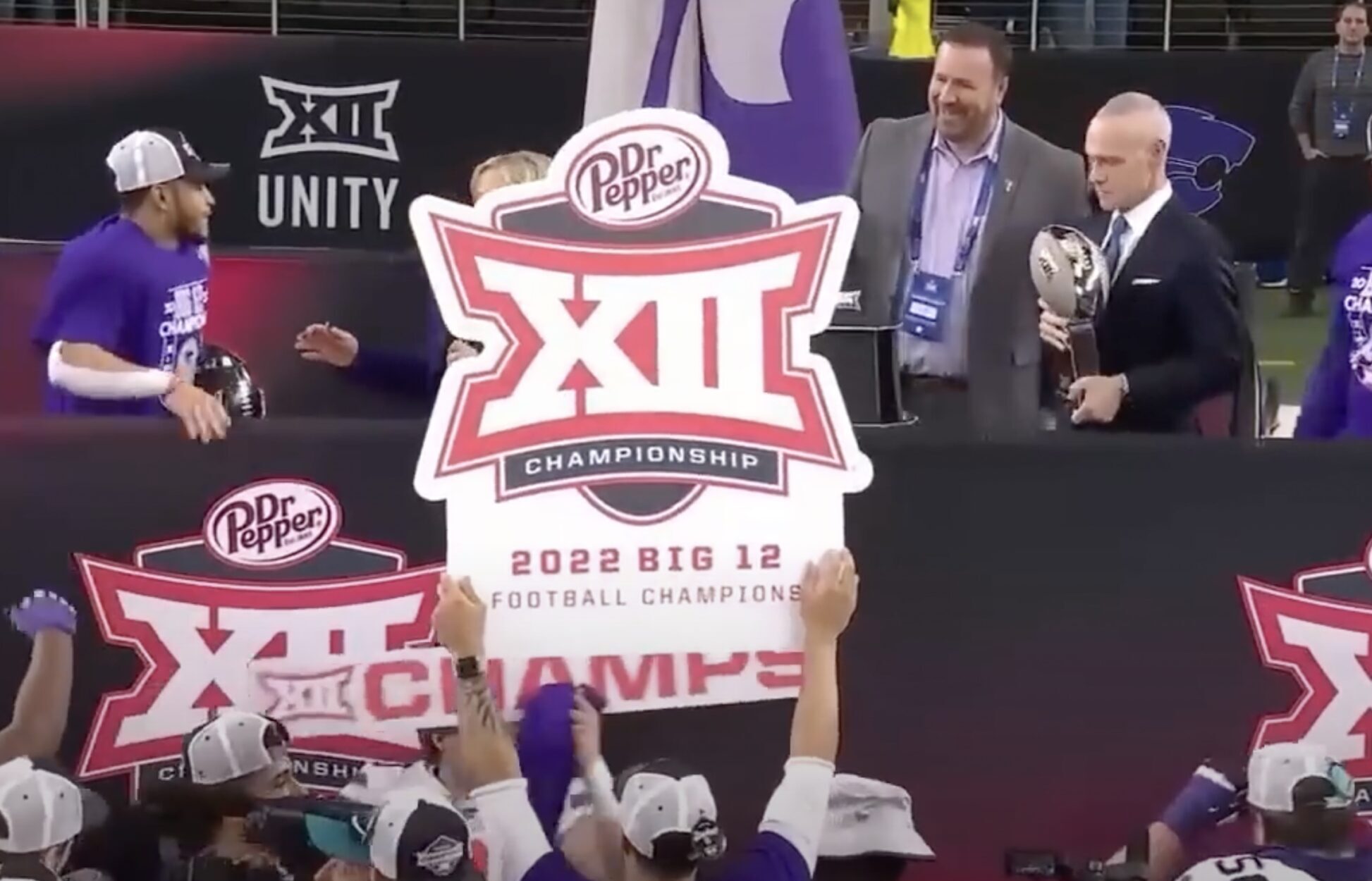
Screenshot
Tier 2 — The Elite League (ACC and Big 12)
The biggest pushback to this proposal will surely come from the teams in this tier, and the two conferences themselves — who fancy themselves on the same level as those in the Super League. But that pushback will be unbelievably short-sighted. End-of season games at the top and bottom of the standings will now mean everything. The top programs will be vying for a berth in the big league — and the massive TV revenue that comes with it. The bottom programs will be desperate to avoid the slide into Tier 3.
And what’s important to remember is that many of the teams in this tier are relatively new to their conferences. The Big 12 and ACC raided other leagues to beef up their rosters. But quantity did not equal quality. SMU, BYU, UCF, Houston and Cincinnati all played in group of five conferences not too long ago. Cal and Stanford are western programs that only joined the southeastern-heavy ACC out of desperation to avoid being left behind. The idea that it’s a birthright for any of these schools to be treated as equals with the likes of Oklahoma and Michigan is absurd.
To make the plan a little more palatable to the current membership, only two teams in this tier will go down at the end of each season, while four teams go up. And for geographic and balance purposes, we’re going to make a few swaps. Cal and Stanford will switch to the Big 12, while UCF, Cincinnati, West Virginia and Houston will head to the ACC. That leaves 15 teams in the ACC, and 14 in the Big 12. (A reminder that Clemson, Miami and Florida State have all been added to the SEC.) To reach a balanced number of 16, we’ll add Oregon State and Washington State to the Big 12, and Memphis to the ACC.
There will be eight teams in each division. (Call them Big 12 Central/West, and ACC North/South.) The regular season schedule will be slightly more difficult to fill out in this tier, but the principle is the same. Five opponents out of division weighted equally based on the previous season’s standings.
The top two in each division qualify for an eight team playoff. The winners of those first round matchups all get promoted. (Big 12 promoted teams land in the Big 10, ACC promoted squads go to the SEC. Last season, SMU, Syracuse, Iowa State and BYU would have been promoted.) Those four remaining teams continue to slug it out for the title of Elite League champion.
The relegation playoffs here are a bit more compact. Only the bottom team in each division qualifies — as opposed to the bottom two in each Super League division. That bottom team will get only one chance for survival — as they are pitted against the bottom team in their conference’s other division. (Last year, the relegated teams would have been Oklahoma State and Stanford.)
I should note that continued shuffling between divisions for geographic purposes is encouraged. For instance, if Cal and Stanford are promoted to the Big 10, and two Eastern squads like Rutgers and Maryland get relegated, then Minnesota and Iowa should slide over to the Big 10 East, and Cal and Stanford should take their places in the Big 10 West.
As I mentioned above, no team in this tier has won a national championship since 1990. Though they may not realize it, this model gets every team in this group closer to actually achieving that goal. One great season and they’re right in the mix — with a fair slice of a massive TV pie at their disposal.
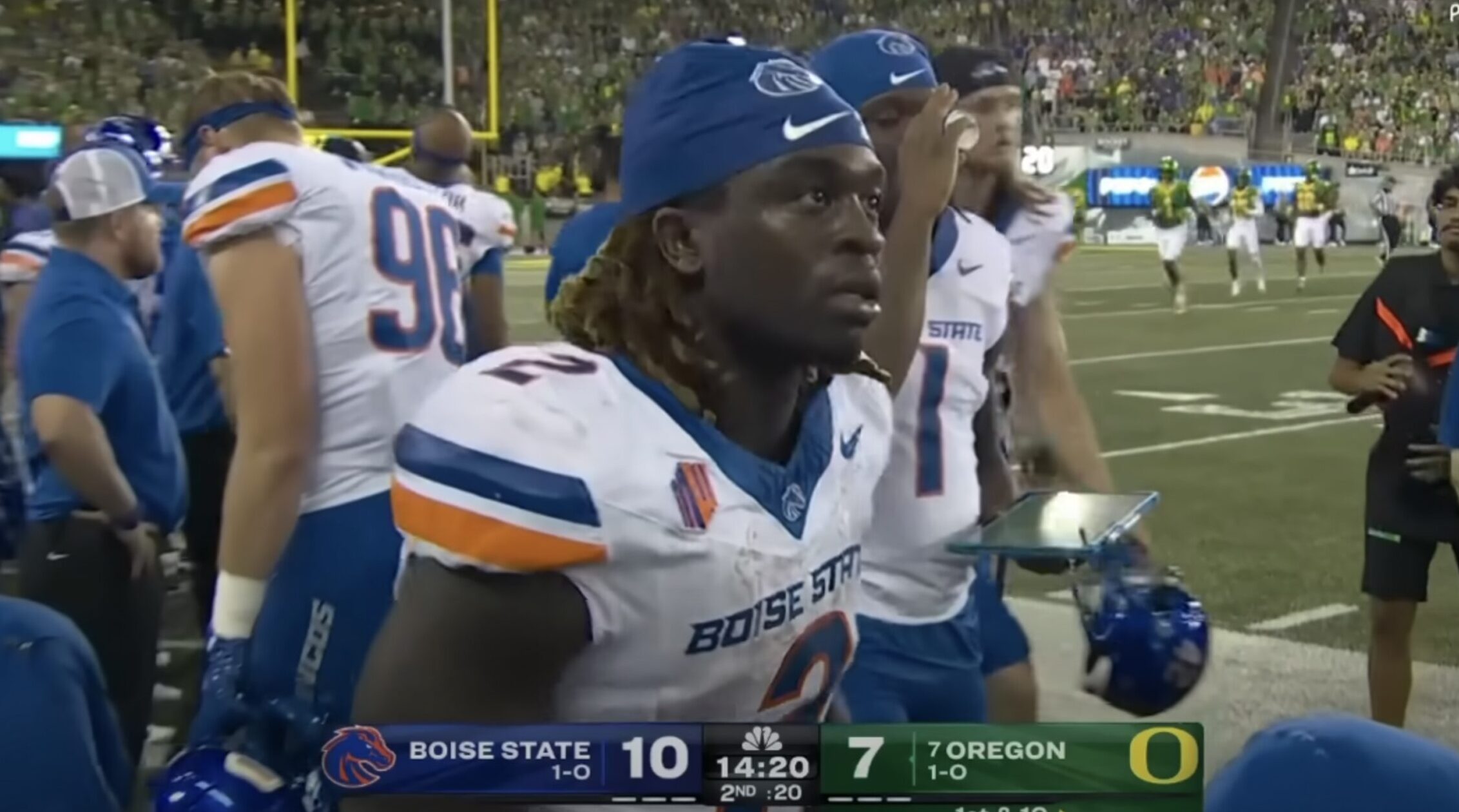
Screenshot
Tier 3 — The Contender League (AAC and PAC 12)
The big debate last year, ahead of the college football playoff, was whether small conference Boise State was as good as Big 10 behemoth Penn State — their opponent in the VRBO Fiesta Bowl. Boise State gave Penn State a competitive game that wasn’t reflected in the 31-14 final score (Boise State’s kicker missed a chip shot field goal that would’ve brought them within one score with less than 10 minutes left), but the framing of the debate was all wrong. The debate should have been whether Boise State is as good as Kentucky, or Northwestern, or Mississippi State. And the answer is: Of course they are. Boise State has won an unfathomable 15 conference championships in the past 25 years. They’ve won three Fiesta Bowls in that time — two to cap off undefeated seasons. They’ve beaten Oregon, Georgia, the vaunted Oklahoma in one of the greatest games ever played. They have repeatedly shown they are infinitely better than the schools they are matched with.
On the merits, Boise State deserves Big 10 membership — or at the very least, Big 12 membership — far more than many of the schools fortunate enough to have landed in the big boy conferences without really earning their spot. And in this system, the smart money says they’ll quickly work their way up to the Super League — where they would then get an equal slice of the TV revenue and be granted home games against the powerhouses who otherwise wouldn’t dare step foot on their Blue Turf. Then, and only then, can we fairly judge this outstanding program against Penn State and their ilk.
Here, they’ll be joined in a new Pac 12 (which currently has six members) by UTSA and Rice from the AAC, Texas State from the Sun Belt, and UNLV/Nevada/Air Force from the Mountain West. The AAC will add UCONN from the independent ranks in order to reach 12 members. The schedules in this tier will be (very slightly) imbalanced. Each team will play all 11 conference opponents. The 12th game will match up the two teams from each conference who finished in the same position in the previous year’s standings. So the bottom teams will have one slightly easier game than the top teams.
The top team in each division qualifies for the contender league playoffs. Winners of those semifinal round games get promoted. (PAC 12 winner to the Big 12, AAC winner to the ACC.) Bottom team in each division goes to the relegation playoffs. (PAC 12 loser to the MAC, AAC loser to the Sun Belt.)
One other thing worth mentioning here as we move along — if you’ve been counting all these playoff games, you’ll note that we’re racking up a good amount of postseason inventory for TV networks to buy. There are five postseason games in this tier alone, plus nine in the Elite tier, and let’s add the six relegation games in the first tier, and a few more still to come in Tiers 4 and 5.
Not counting the bowls that are part of the college football playoff, there were 34 bowl games last season. But under this new system, these previously irrelevant bowl games will actually mean something. We can conveniently convert bowl games into lower tier playoff matchups. So the 68 Ventures Bowl in Mobile — the type of game that only the biggest of degenerate gamblers would typically watch — now becomes a fight-to-the-death survival match between two schools desperate to stay on their current level. Surely that’s worth a few more bucks to sponsors like 68 Ventures.
And that will solve what has become an enormous problem in bowl games — players sitting out so as not to endanger their prospects for next season in either the transfer portal or the NFL draft. With real stakes now attached to these games, rosters are much more likely to stay intact.
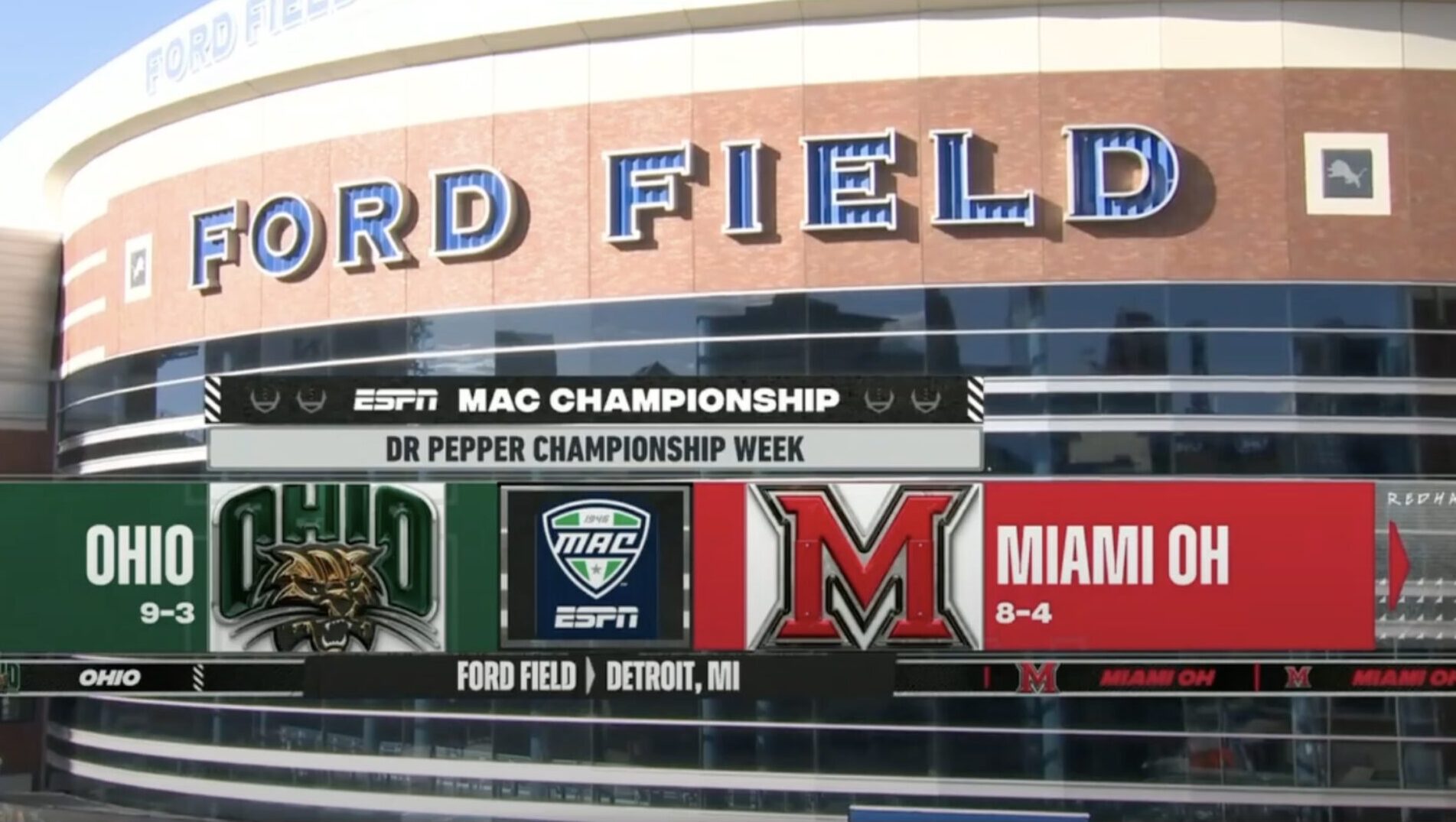
Screenshot
Tier 4 — The Up-and-Comer League (MAC and Sun Belt)
This level will work a little differently. Each conference will have 13 teams (Northern Illinois will remain in the MAC, rather than make the geographically absurd move to the Mountain West) and that number — odd as it may seem — actually makes scheduling pretty simple. Each team plays everyone else in the conference. Nice and easy. And it will make travel much less costly for these schools with smaller budgets.
Two teams go up, two go down. The postseason will work the same as in Tier 3. Top two in each conference square off at season’s end to decide who goes up, bottom two meet to sort who goes down. (The MAC loser goes down to the Mountain West, while the Sun Belt loser goes to Conference USA.)
The geography, unfortunately, gets a little dicey here. The MAC winner gets promoted to the Pac 12 — where they will have a slew of western opponents. The MAC will also have to take in the promoted team from the Mountain West. But this type of thing has become a sad reality of college football these days. This model dramatically improves geographic alignment across the board, but unfortunately does not eliminate all suboptimal travel schedules. Still, the promoted teams will be more than happy to make the long trips.

Screenshot
Tier 5 — The Starter League (MWC and Conference USA)
If you’ve been following the show “Welcome to Wrexham” on FX, you’ve seen the incredible rise of the Welsh soccer club Wrexham AFC — which is owned by actors Ryan Reynolds and Rob McIlhenney. When Reynolds and McIlhenney purchased the team, they were mired in the dregs of Tier 5 of English football. But in just three years, they managed to work all the way up to Tier 2, and are now knocking on the door of the Tier 1 Premier League — where they would compete with some of the biggest soccer clubs in the world.
If you’re a fan of Louisiana Tech, or Florida International, or Middle Tennessee, you now get to plausibly dream that dream. You are four good seasons away from sharing a conference with Alabama, and Auburn, and LSU. It is eminently possible — just look at Wrexham. Wrexham was the Middle Tennessee of English football just three years ago. This season, they will share a conference with the English football equivalent of Colorado, Virginia Tech, and Oklahoma State. One more big year, and they’re in the Premier League with the giants of the sport — Manchester United, Liverpool, Arsenal. Just imagine a stratospheric rise like that in college football. It would be something to behold.
But Wrexham isn’t a classic Cinderella story. Their rise has been fueled by cash — as they have outspent many of their peers on their way up the ranks. And you can count on the same thing happening here. A well-heeled alum at a Tier 5 school can pump money into the program knowing there’s a realistic chance they will see a massive return in several years.
And that’s why the Tier 2 teams who will be the loudest opponents of a plan like this needn’t worry that they will be rendered irrelevant. Because in this system, even Tier 5 is relevant. Everyone will be looking to move up. The money will flow from the bottom tier all the way to the top. Everyone involved on every level — including and especially the players — will get very rich.
Thanks to some new additions, there are, unfortunately, eight teams in each conference. There will be no cross-conference games. (We’re not going to make Delaware travel to Hawaii. So instead, the teams will play five of their seven conference rivals twice (one at each team’s home stadium), while playing the other two only once.
Top two in each conference make the playoffs, winners get promoted to Tier 4. And the innocent climb up the college football pyramid begins.
***
ODDS AND ENDS
Couple of additional notes:
A 13th exhibition game would likely be necessary — where anyone can play anyone else on any tier. While most rivalries have been preserved in this structure, a few have been separated by tier. (Kentucky vs. Louisville is one that jumps out.) Promotion and relegation may break up additional rivalries going forward. The 13th game gives those rivalries a chance to continue. And for other teams, it’s a chance to get a warm-up game in. Smaller schools can continue to get those big payouts which bolster their athletic budgets, while the big boys can work out the kinks ahead of a grueling Super League slate. Plus, the powerhouses often have eight-game home schedules. Going forward, they will only have six Super League home games. The 13th game would give those teams another gate.
Still, there shouldn’t be any worries about ticket revenue going down — even with one or two fewer home games. The infinitely stronger home slate will more than justify a dramatic increase in prices.
The English Premier League has, as part of its system, “parachute payments” — which dictates that a portion of its revenue goes to teams the first year after they are relegated, so that their budgets aren’t completely shattered. Something similar would likely need to be worked out in this model. (Perhaps, as an inducement to get the vulnerable Tier 1 teams to commit, there could be some type of guarantee where all original Tier 1 teams get a full slice of the pie for the first few years — whether or not they are relegated.)
So go ahead, college football power brokers. Go ahead and nitpick this proposal. Go find the flaws. I wouldn’t dare suggest what I’ve offered up here is perfect, or even close. Some tweaks will surely be needed.
But when you scrutinize this plan, make sure to also consider the utter absurdity of what you have in place right now, as well as what’s being discussed. You’ve got Stanford sharing a conference with Florida State. Northern Illinois soon to be league-mates with Hawaii. The current system is a joke.
Now is your chance — perhaps your last chance — to fix it.
——
Joe DePaolo is the Co-Managing Editor of Mediaite.
This is an opinion piece. The views expressed in this article are those of just the author.




